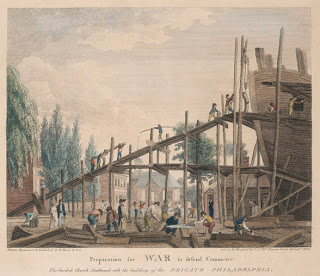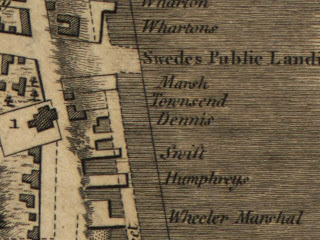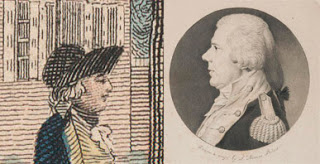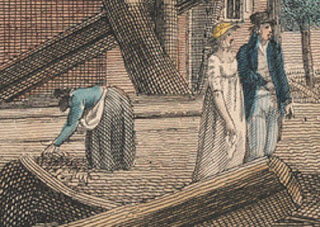We often regret that no visitor to Edmund Hartt’s shipyard between the years 1795 and 1797 had the courtesy to take up pencil, pen, or brush to give us a depiction of Constitution under construction in Boston’s North End waterfront. In fact, it would be almost six years after the ship’s launch before an artist made an image of Boston’s favorite ship.
Fortunately, the Museum’s collection contains a contemporary image that gives us a glimpse of what a working shipyard looked like. Its full title reads: Preparation for WAR to defend Commerce. This charming hand-colored print was one of a series of views of Philadelphia drawn and engraved by William Birch and his son, Thomas, in 1800. The series depicts the thriving metropolis in the year before the national capital removed to the new federal city at Washington. Most of the prints include views of public buildings and elegant streets, genteel houses and feats of civil engineering.


The figure in the center, dressed in a buff and blue uniform, has frequently been interpreted as Joshua Humphreys himself. This seems unlikely. For one thing, he is wearing a captain’s uniform as prescribed in the 1797 regulations. For another, the ship was designed by Josiah Fox and built by Samuel Humphreys (Joshua’s son), Nathaniel Hutton, and John Delavue. The likely identity of this figure is Captain Stephen Decatur, Sr. He was the father of Stephen Decatur, Jr. who would gain fame in the Barbary Wars by destroying the very frigate his father once commanded. The elder Decatur received orders to take command of the frigate on June 20, 1799, and that date fits well with the state of construction depicted by Birch. The frigate was not ready to launch until the end of November.

All in all, Birch gives us a faithful depiction of a busy shipyard in the closing years of the 18th century. A year after the image was published, this land and the adjoining plots were purchased by the federal government to form the core of what would become the Philadelphia Navy Yard. Before the yard moved down river to League Island in 1879, the yard launched some of the iconic vessels of the 19th century, including the enormous 136-gun ship Pennsylvania.
The Author(s)
Matthew Brenckle
Research Historian, USS Constitution Museum
Matthew Brenckle was the Research Historian at the USS Constitution Museum from 2006 to 2016.
